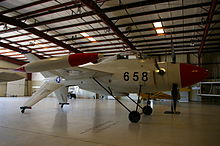Lockheed XFV
The Lockheed XFV originated as a result of a proposal issued by the U.S. Navy in 1948 for an aircraft capable of vertical takeoff and landing (VTOL) aboard platforms mounted on the afterdecks of conventional ships.
Both Convair and Lockheed competed for the contract but in 1950, the requirement was revised, with a call for a research aircraft capable of eventually evolving into a VTOL ship-based convoy escort fighter.
[3] Lockheed employees derisively nicknamed the aircraft the "pogo stick" (a direct reference to the rival Convair XFY's name).
With the realization that the XFV's top speeds would be eclipsed by contemporary fighters and that only highly experienced pilots could fly the aircraft, the project was cancelled in June 1955.
[5] Salmon taxied the XFV-1 on its temporary gear "from a standing start to 175 mph, and then brought it back down to a dead stop without any use of the brakes, all within a distance of one mile.


